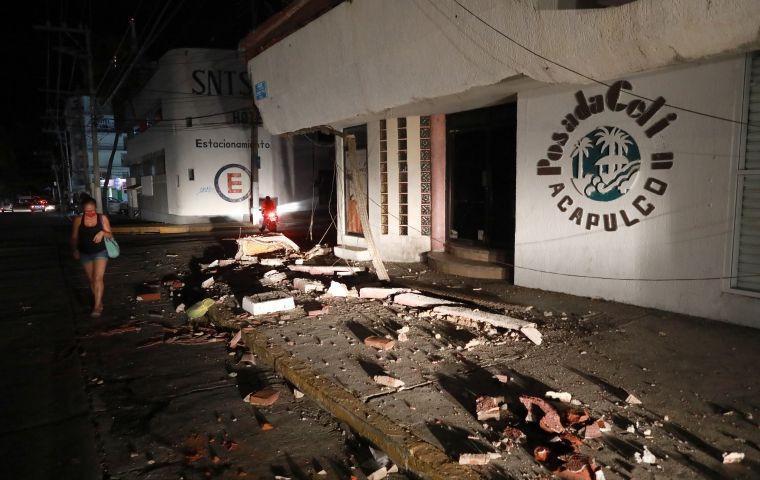MercoPress. South Atlantic News Agency
New earthquake hits Mexico near Acapulco but floods kill more in Tula
 Some 1.6 million people were affected by power cuts
Some 1.6 million people were affected by power cuts Exactly four years after Mexico was shaken by the second most intense earthquake in its history, a 7.1 magnitude tremor with an epicentre 11 kilometres southeast of Acapulco hit the country again Tuesday.
On September 7, 2017, an earthquake was recorded 133 kilometres southeast of Pijijiapan, Chiapas. It was the strongest, although not the most devastating, earthquake in almost 100 years in the country. With a magnitude of 8.1, it was the most severe one since June 3, 1932, when an 8.2 earthquake occurred between the coasts of Colima and Jalisco.
Local governments were holding commemorative events Tuesday marking the fourth anniversary of the 2017 event which resulted in 99 deaths when earth movements made the news once again.
But this time around damages were very little compared to past experiences as seismic alert system played a key role, allowing people to seek shelter on time.
The earthquake originated some 14 kilometres from Acapulco, in the state of Guerrero, and left at least one dead and 1.6 million people without electricity. The earthquake took place at 8:47 p.m. local time.
President Andrés Manuel López Obrador first said that “Fortunately, there is no serious damage,” but updates are expected on the matter.
After the Guerrero earthquake protocols were activated, the states of Querétaro, Veracruz, Tlaxcala and Puebla began inspection tours of the buildings. Mexico City Mayor Claudia Sheinbaum also released a video on social media where she announced the activation of security protocols.
“Three overflights have been made and no damage has been found. I just spoke with the president and gave him this information. We know that there are many places without electricity, I ask everyone for peace of mind,” she said.
The Federal Electricity Commission reported that 1.6 million people in Morelos, Oaxaca, the State of Mexico and Mexico City were affected by power outages. Some people who were travelling on line one of the cable bus (cable car) in the capital were trapped during the earthquake.
What the earthquake did not case, floods did. At least 17 patients died after floods swept through a hospital in Tula following heavy rain. “I am very saddened by the death of 17 hospital patients,” López Obrador said.
The hospital was flooded in a matter of minutes, and a power cut disrupted oxygen treatment, said Zoe Robledo, general director of the Mexican Institute of Social Security, which operates the facility, from where 56 patients were relocated to other health care centres. Among the dead were COVID-19 patients who needed oxygen therapy to stay alive.
In another, unrelated event in Mexico which made international headlines Tuesday, the country's Supreme Court unanimously ruled on Tuesday that penalizing abortion was unconstitutional. The decision in the world's second-biggest Roman Catholic country means that courts can no longer prosecute abortion cases, and follows the historic legalization of the right in Argentina, which took effect earlier this year. The court's ruling stemmed from a 2018 case challenging a criminal law on abortion in Coahuila, a northern Mexican state which borders Texas, which has just tightened its laws.




Top Comments
Disclaimer & comment rulesCommenting for this story is now closed.
If you have a Facebook account, become a fan and comment on our Facebook Page!